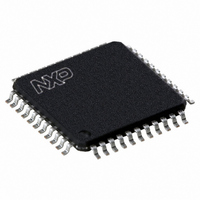P89V662FBC,557 NXP Semiconductors, P89V662FBC,557 Datasheet - Page 17

P89V662FBC,557
Manufacturer Part Number
P89V662FBC,557
Description
IC 80C51 MCU FLASH 32K 44-TQFP
Manufacturer
NXP Semiconductors
Series
89Vr
Datasheet
1.P89V660FBC557.pdf
(89 pages)
Specifications of P89V662FBC,557
Program Memory Type
FLASH
Program Memory Size
32KB (32K x 8)
Package / Case
44-TQFP
Core Processor
8051
Core Size
8-Bit
Speed
40MHz
Connectivity
I²C, SPI, UART/USART
Peripherals
POR, PWM, WDT
Number Of I /o
36
Ram Size
1K x 8
Voltage - Supply (vcc/vdd)
4.5 V ~ 5.5 V
Oscillator Type
Internal
Operating Temperature
-40°C ~ 85°C
Processor Series
P89V6x
Core
80C51
Data Bus Width
8 bit
Data Ram Size
1 KB
Interface Type
I2C/UART
Maximum Clock Frequency
40 MHz
Number Of Programmable I/os
36
Number Of Timers
3
Operating Supply Voltage
4.5 V to 5.5 V
Maximum Operating Temperature
+ 85 C
Mounting Style
SMD/SMT
3rd Party Development Tools
PK51, CA51, A51, ULINK2
Minimum Operating Temperature
- 40 C
Lead Free Status / RoHS Status
Lead free / RoHS Compliant
For Use With
622-1001 - USB IN-CIRCUIT PROG 80C51ISP
Eeprom Size
-
Data Converters
-
Lead Free Status / Rohs Status
Lead free / RoHS Compliant
Other names
568-2435
935280832557
P89V662FBC
935280832557
P89V662FBC
Available stocks
Company
Part Number
Manufacturer
Quantity
Price
Company:
Part Number:
P89V662FBC,557
Manufacturer:
Maxim
Quantity:
260
Company:
Part Number:
P89V662FBC,557
Manufacturer:
NXP Semiconductors
Quantity:
10 000
NXP Semiconductors
P89V660_662_664_3
Product data sheet
6.2.3 Reset
Table 8.
Not bit addressable; Reset value 00H
Table 9.
At initial power-up, the port pins will be in a random state until the oscillator has started
and the internal reset algorithm has weakly pulled all pins high. Powering up the device
without a valid reset could cause the MCU to start executing instructions from an
indeterminate location. Such undefined states may inadvertently corrupt the code in the
flash. A system reset will not affect the on-chip RAM while the device is running, however,
the contents of the on-chip RAM during power-up are indeterminate.
When power is applied to the device, the RST pin must be held high long enough for the
oscillator to start-up (usually several milliseconds for a low frequency crystal), in addition
to two machine cycles for a valid power-on reset. An example of a method to extend the
RST signal is to implement a RC circuit by connecting the RST pin to V
capacitor and to V
During initial power the POF flag in the PCON register is set to indicate an initial power-up
condition. The POF flag will remain active until cleared by software.
Following a reset condition, under normal conditions, the MCU will start executing code
from address 0000H in the user’s code memory. However if either the PSEN pin was low
when reset was exited, or the Status Bit was set = 1, the MCU will start executing code
from the boot address. The boot address is formed using the value of the boot vector as
the high byte of the address and 00H as the low byte.
Bit
7 to 4
3
2
1
0
Bit
Symbol
Fig 5. Dual data pointer organization
AUXR1 - Auxiliary register 1 (address A2H) bit allocation
-
AUXR1 - Auxiliary register 1 (address A2H) bit description
Symbol
-
GF2
0
-
DPS
7
DPS = 0
DPS = 1
SS
AUXR1 / bit0
-
Rev. 03 — 10 November 2008
through an 8.2 k resistor as shown in
DPS
6
DPTR0
DPTR1
Description
Reserved for future use. Should be set to ‘0’ by user programs.
General purpose user-defined flag.
This bit contains a hard-wired ‘0’. Allows toggling of the DPS bit by
incrementing AUXR1, without interfering with other bits in the register.
Reserved for future use. Should be set to ‘0’ by user programs.
Data pointer select. Chooses one of two Data Pointers for use by the
program. See text for details.
-
5
DPH
83H
80C51 with 512 B/1 kB/2 kB RAM, dual I
-
4
DPL
82H
DPTR1
DPTR0
GF2
P89V660/662/664
3
external data memory
Figure
0
2
002aaa518
6.
-
© NXP B.V. 2008. All rights reserved.
DD
1
through a 10 F
2
C-bus, SPI
DPS
17 of 89
0
















